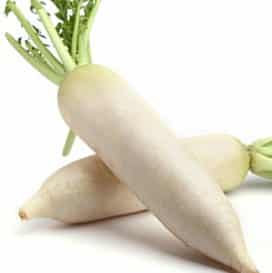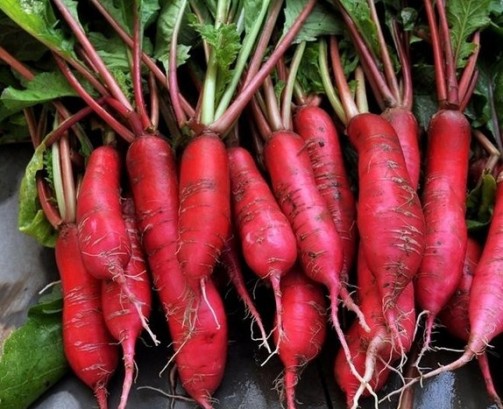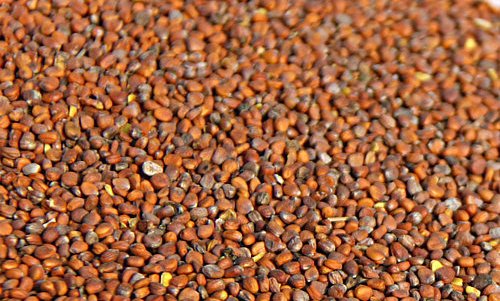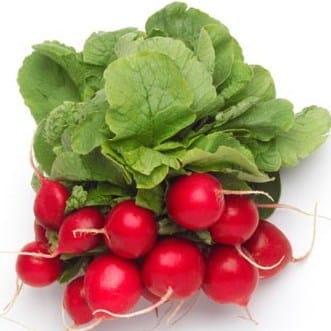Growing Radish Guide:
Introduction to Growing Radish:- Radish is one of the popular vegetable crops grown for its tender tuberous roots in tropical and sub-tropical regions of the world. Radish can be consumed as raw and cooked. Radish is used in most Indian dishes like curries and sambar. This vegetable has an excellent demand throughout the world. This vegetable can be grown in your backyard, containers, pots even in Polyhouse. This vegetable has many varieties depending on sizes, colour, flavour, and maturity time. Apart from the root, the leaves of radish are also edible. Radish has excellent health benefits. Cultivation practices of radish depend on whether it is grown for vegetable purposes or seed purposes. When it comes to roots, their skin colour can range from white through red, purple, pink, yellow, and green to black. However, its flesh is usually white.
Radish crops are worked out as companion plants for many other main crops. This is due to the fact that their pungent odour deters many insect pests. Some of the insect pests that can be controlled with this trap crop are aphids, c squash bugs, ants, cucumber beetles, and tomato hornworms. One can expect good profits with this crop throughout the year due to good demand in local vegetable markets. To be successful in growing radish vegetable, It requires hard work, passion, and dedication. Now let us get into details of growing radish from seed to harvest.
Scientific Name / Botanical Name of Radish:- Raphanus raphanistrum subsp.
Family Name of Radish:- Brassicaceae.
Genus of Radish:- Raphanus.
Common Names of Radish or Other Country Names:-
- Afrikaans – radys
- Dutch – radijs
- German – Radieschen
- Polish – rzodkiewka
- Albanian – Rrepkë
- Estonian – redis
- Greek – Repáni
- Irish – Raidis
- Korean – mu
- Maltese -Rediska
- Nepali – Mula
- Portuguese – Rabanete
- Spanish – Raphanus sativus
- Arabic – fegla
- Bulgarian – repichka
- Filipino – labanos
- Italian – Ravanello
- Norwegian – reddik
- Thai – Hua Piahs
- Vietnamese – Cu Cai Trang
- Poghg – Poghg
- Burmese – Mone Lar Oo Phyu
- Croatian – Radish
- Finnish – Retiisi
- Hebrew – tsnon
- Japanese – daikon
- Latvian – Redīss
- Romanian – ridiche
- Sinhalese – Rabu
- Czech – ředkev
- French – radis
- Swedish – rädisa
- Turkish – Turp
- Danish – ræddike
- Georgian – boloki
- Hungarian – Retek
- Malay – Lobak putih
- Persian – torob
- Taiwanese – zhaethaau
- Sanskrit – Mulika
Radish in Indian Languages: – The following are local Radish names in India.
- English – Radish
- Hindi – Mooli / Mula
- Tamil – Mulanki,
- Malayalam – Mullangi / Kanaka Pala
- Marathi – Mulae / Mula
- Telugu – Mullangi
- Kannada – Mullangi
- Bengali – Mulo
- Konkani – Mullo
- Oriya – Mula
- Punjabi – Muli / Mula
- Tulu – Mullangi
Indian Top 10 Production states of Radish:-
- West Bengal
- Haryana
- Assam
- Bihar
- Chhattisgarh
- Orissa
- Jammu & Kashmir
- Uttar Pradesh
- Karnataka
- Tripura
Health Benefits of Radish:- Some of the health benefits of Radish vegetables are as follows.

- Radish is a good source of fiber hence excellent for digestion and relieving from constipation problems
- Radish helps in controlling damage to our red blood cells and improves the oxygen supply to the blood
- Regular consumption of radish vegetable can reduce the risk of cardiovascular diseases (heart disease)
- Radish can lower blood pressure due to the presence of potassium
- Regular consumption of this wonderful root boosts the immune system
- Radish is good for fortifying blood vessels
- Apart from digestion, this root can also help to fix obesity, gastric problems, acidity, and nausea
- Red radish is a good source of nutrients. It contains Vitamins E, A, C, B6, and K. They are also a good source of antioxidants and fiber, and minerals like zinc, potassium, phosphorous, magnesium, copper, calcium, iron, and manganese.
- Radish is good for skin health
- Radish is good for hydration
Varieties / Types (Cultivars) of Radish:- The following are some of the common radish types grown.
- Japan ball
- French Breakfast
- Beeralu rabu
- Co 1
- Scarlet globe
- Rapid Red White Tipped
- Pusa Rashmi,
- Pusa Chetki,
- Pusa Desi,
- Japanese White
- Arka Nishant
- Sparkler
- Table radish
- White Icicle
- Cherry Belle
- White Beauty
- Early Scarlet Gold
- Daikon Long White
- Fire and Ice

Climate Requirement for Growing Radish:- Radish vegetables can be grown in all agro-ecological regions of the world. However, these vegetables are best grown in cool or moderate climatic conditions. Radish can develop good flavour and texture at lower temperatures around 20 to 25°C. In case of high temperature especially during hot weather conditions, the roots of radish will come pungent before reaching edible size.
Soil Requirement for Growing Radish:- Radish vegetables can be grown in a wide range of soils. However, they can be grown best in sandy loam soils with high organic matter content. Commercial vegetable growers should go for soil tests to find out the suitability and fertility of the soil. The ideal soil pH range of 5.5 to 7.0 results in a good yield of produce, best root size, flavor, and texture. Try to avoid heavy soils or black cotton soils.
Land Preparation for Growing Radish:- Land should be prepared thoroughly and you must ensure that no clods or under decomposed manures are left in the soil. Give a couple of ploughings to bring the soil to fine-tilth stage and uniform level. Soil should be ploughed to a depth of 30 to 40 cm to provide fine tilth. You can supplement the soil with well-decomposed farmyard manure (FMY) like cow dung or any garden compost in the last plough land preparation.
Propagation for Growing Radish:- Radish crop is propagated through seeds.
In case if you miss this: Organic Vegetable Farming Plan.

Seed Rate, Season, Sowing, and Spacing for Growing Radish:- Seed rate of radish crop depends on planting method and variety. On average 8 to 10 kg of seed per hectare is required. Radish can be grown as a rainfed as well as an irrigated crop. This crop can be grown throughout the year provided there is a good irrigation facility. The onset of monsoons (June to July) in hills and September in plains are the best suited seasons for growing radish crops.
Note: Planting season varies from region to region.
The radish vegetable crop can be sown on ridges, furrows, and flatbeds. The distance between ridges and furrows or on flatbeds depends upon a variety of radish.
For Dibble in rows on raised beds
- Spacing of 25 to 30 cm between rows and 10 cm between plants.
- Spacing for table radish is 20 cm X 5 cm
- It is recommended to plant two seeds per hill and thin out one at germination

Irrigation for Growing Radish:- A radish crop requires continuous moisture in the soil throughout its growth period. Make sure to irrigate the field even before sowing so that germination percentage will increase. This crop requires frequent and uniform irrigation and you should avoid any water stress especially the flowering and root development stage.
Irrigate daily for the first 4 to 5 days, subsequently every 3 to 4 days depending on climate and soil moisture level. Drip irrigation is the best bet for this crop. Avoid any waterlogging (stagnation) in the field. You should provide well-drainage in case of heavy rains or floods.
Intercultural Operations in Growing Radish:- Any vegetable crop requires timely intercultural operations for better yield and quality of produce. In Radish farming, hand weeding 3 weeks after planting is advised. Hoeing should be carried out as and when necessary. Thinning of dense plants should be done at the time of second weeding. The radish plant roots have a tendency to bulge out of the soil therefore covering the roots by earthling up is essential.
Manures and Fertilizers for Growing Radish:- Proper and timely application of manures and fertilizers will result in higher yields of crop and top-quality roots. Don’t apply fresh manure in the field as a radish crop is a short duration. This can result in forking and irregularly shaped roots. Well-decomposed farmyard manure of 25 tonnes per hectare can be applied during preparation.
Fertilizer basal application (at planting time)
- Urea : 90kg/ha
- Tri superphosphate : 110 kg/ha
- Muriate of potash:- 65 kg/ha
Topdressing application (3 weeks after planting)
- Urea : 90 kg/ha
- Muriate of potash: 65 kg/ha
Pests and Diseases in Growing Radish:- Plant care growing radish is very important till the maturity of roots.
- Pests: Aphids, flea beetles, and mustard sawflies are common insect pests found in growing radish.
Control measures: These pests can be controlled by spraying Malathion 50 EC 1 ml/1 liter of water twice or thrice at 10 days intervals.
- Diseases: White rust is a common disease found in radish plantations.
Control measures: White rust can be controlled by spraying Copper oxychloride 2 grams/ 1 liter of water.
Note: Your local department of horticulture is a good source of finding information about pests and diseases in Growing Radish. Don’t experiment on your own without knowing the symptoms and causes.
Harvesting in Growing Radish:- Well, the maturity of radish roots depends on the cultivar. Generally, these roots become ready for picking in 45 to 50 days where some early varieties become ready in 30 days after sowing in the field. It is very important to harvest the crop at right time otherwise the crop will end up in bitter roots (keeping for a prolonged period in the soil after the harvesting stage).
Marketing of Radish:- Cleaned and packed radish boxes should be transported to local markets. Some farmers sell their produce at the farm gate.
Yield in Growing Radish:- Yield of any crop depends on many factors such as variety, soil type, climate, plant stage, method of planting, seed rate, and other garden management practices. Usually on average, one can obtain a yield of 100 to 200 quintals/ha. However, there are high-yielding hybrid cultivars that can fetch a yield of 300 to 400 quintal/ha. Expect lower yields temperature varieties or when grown in hot weather conditions.
In case if you miss this: Growing Vegetables Hydroponically.
- Pig Fattening Essentials: From Selection to Sale for Beginners
- Raising Wagyu Cattle: A Complete Guide for Premium Beef Production
- Soil Types and Their Water Holding Capacity
- Optimizing Irrigation Schedules for Coconut Groves for Enhanced Yield
- Espresso Your Garden: Coffee Grounds for Healthier Acid-Loving Plants
- The Best Soil Mix for Snake Plants: How to Mix Your Own Snake Plant Soil
- Green Thumb Success: Expert Tips for Cultivating Greenhouse Beans All Year Round
- Bloom All Year Round: The Ultimate Guide to Indoor Hyacinth Care
- Eco-Friendly Gardening: How to Make Liquid Fertilizer from Kitchen Waste
- Ultimate Guide to Grow Anise in Pots: Explore Seed Propagation to Harvesting
- Guide to Raising Chester White Pigs: Discover Breed Facts to Growth Management
- Mastering the Elegance: The Ultimate Guide to Weeping Cherry Tree Care, Planting, and Maintenance
- Ultimate Guide to Planting Garlic in Grow Bags: Growing Strategies for Beginners
- How to Fix Spider Plant Leaf-Related Problems: Natural and Organic Remedies
- 10 Reasons Why Your Tulsi Plant is Shedding Leaves: Home Remedies and Solutions
- Optimizing Growth and Yield: The Advantages of Palm Bunch Ash Fertilizer
